Iceland volcano: Why this ash cloud is different from last year

Iceland's Grimsvotn volcano has sent thousands of tonnes of ash into the sky over the last few days, raising fears of a repeat of the travel chaos seen across northern Europe almost a year ago.
The ash cloud reached the U.K. on Tuesday morning and has since spread across northern Europe causing disruption to hundreds of flights and raising fears of a similar scenario to last year - when European airspace shut-down for six days after the Eyjafjallajokull volcano, also in Iceland, erupted. More than ten million people were affected and airlines lost around £1.3bn.
Compared with other kinds of mineral dusts (e.g. desert sands), volcanic ash is worse for aviation because it melts at lower temperatures and is sharper and more abrasive. Inside an operating jet engine it can basically turn back into lava. There have probably been hundreds of encounters between aircraft and volcanic ash clouds, some of which almost ended in tragedy. But even the minor, unreported incidents will have degraded engines, windshields and fuselage surfaces through abrasion with the ash particles.
But experts have said that this eruption is different to last year's and there are two main reasons to remain optimistic that a similar scenario will be averted this time:
#1 Different eruption
Experts agree that the intensity of the Grimsvotn eruption may mean it quickly quietens down and causes only passing disruption to air travel across Europe.
The volcano erupted on Saturday with a huge explosion that sent a plume of ash 14 miles into the sky. The eruption is believed to be the most powerful in Iceland in more than 50 years. At the time, the volcano was blasting roughly 100 times more material per second into the atmosphere than was released from the Eyjafjallajökull volcano last April.
But the initial force of the blast means the volcano might have spent much of its energy already and, at least as far as the latest eruption goes, the worst may be over.
"The gigantic initial volcanic plume suggests that it may exhaust itself and cease quicker than the Eyjafjallajökull eruption," said Gillian Foulger, professor of geophysics at Durham University.
Scientists have also speculated that the ash particles from this eruption are larger and, as a result, fall out of the atmosphere much faster. Reducing the impact of the ash cloud on aircraft flying through the fallout.
It seems as if the ash cloud from the Eyjafjallajokull eruption was an unusual event, significantly different to the current scenario.
According to the BBC, the basalt in Eyjafjallajokull had a high silica content, which gave it the explosive capacity to produce small sizes of ash able to hang in the atmosphere for long periods. Whereas the the composition of the magma in the latest eruption is coarser, which means it should fall out of the sky much quicker.
#2 Procedural changes
Despite a difference of opinion between German air traffic controllers and the rest of Europe yesterday, the changes brought about after last year's eruption have reduced disruption.
EU transport commissioner Siim Kallas said invaluable lessons were learned after last year.
"Europe is now equipped to respond with graduated response rather than a one size fits all approach," he said.
"This should avoid blanket closure of our air space and we have seen in the first 48 hours, the new EU procedures are working."
The graduated response comes in the form of a new system enforced by the Civil Aviation Authority (CAA) that divides airspace into three areas of concentration: low, medium and high density ash.
Airlines wishing to fly in the top two categories need to apply for permission to do so.
And since last year's eruption the authorities have gained a much better understanding of the risk from ash clouds, he said.
Philip Hammond, the transport secretary, who has promised there will be no blanket airspace closures similar to those last year, suggested on the BBC's Newsnight on Monday that "we have got to learn to live" with disruption. There were now "much more robust systems to minimise the disruptive effect", he said.
"What we can't promise is that there won't be disruption when there is a major natural event like this."
© Copyright IBTimes 2024. All rights reserved.






